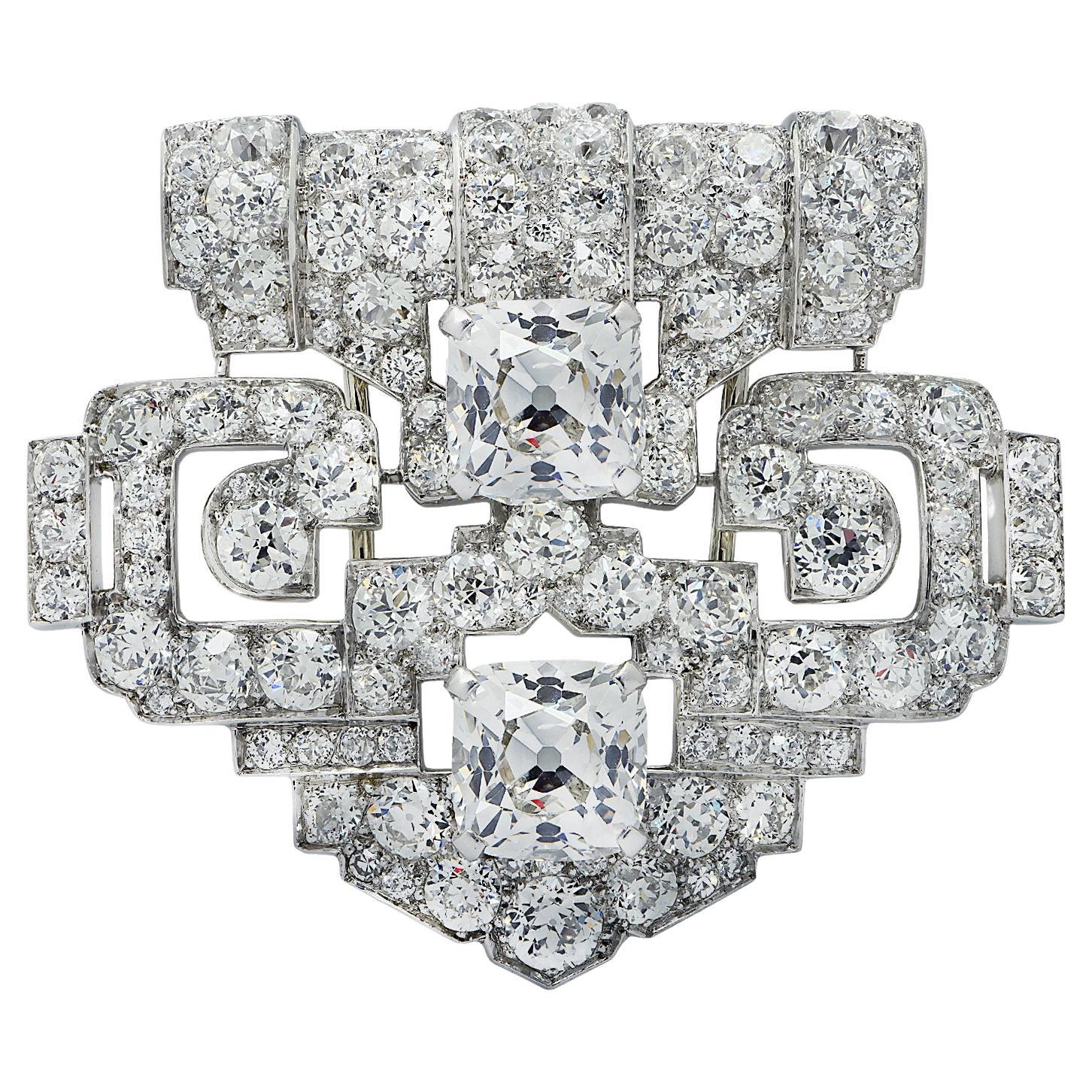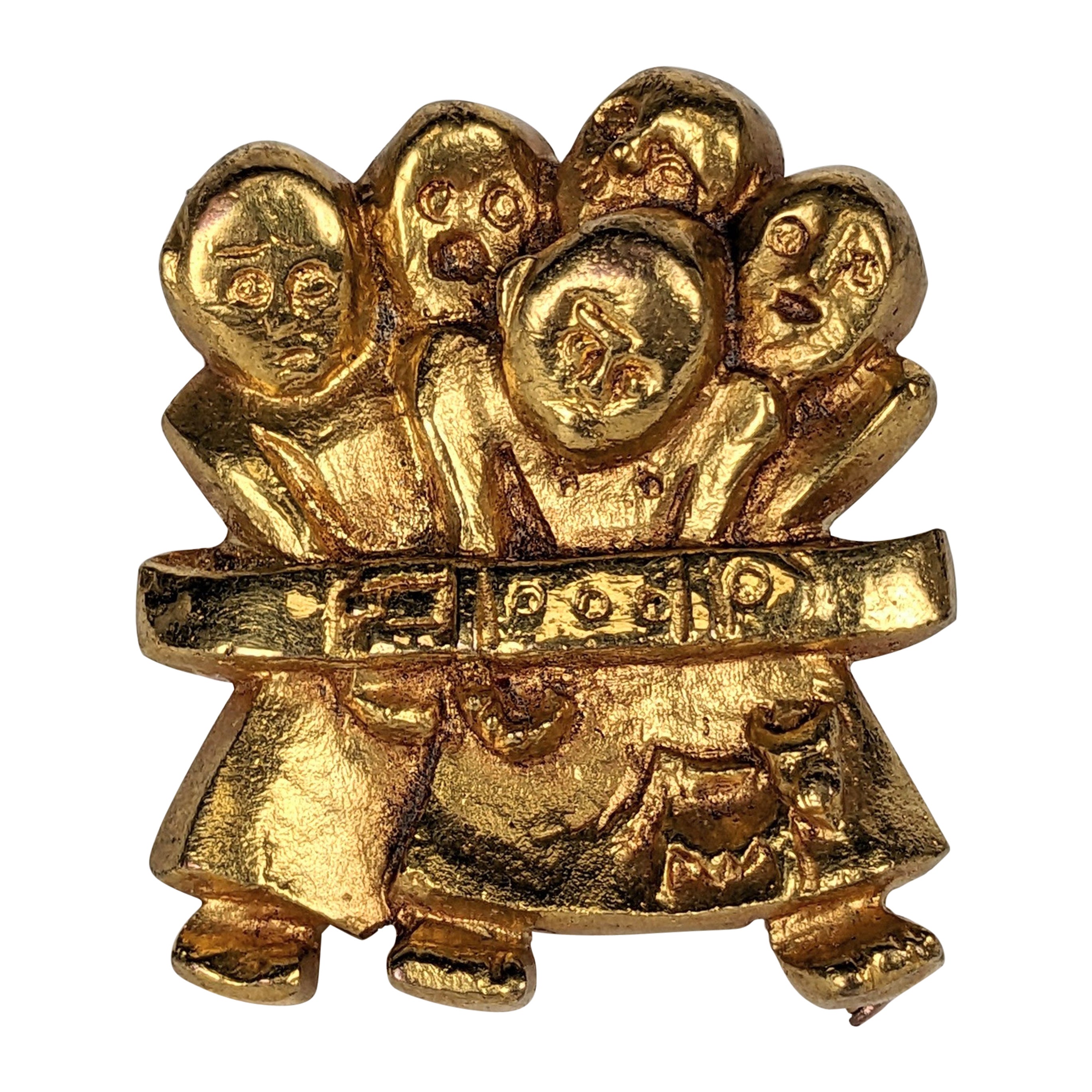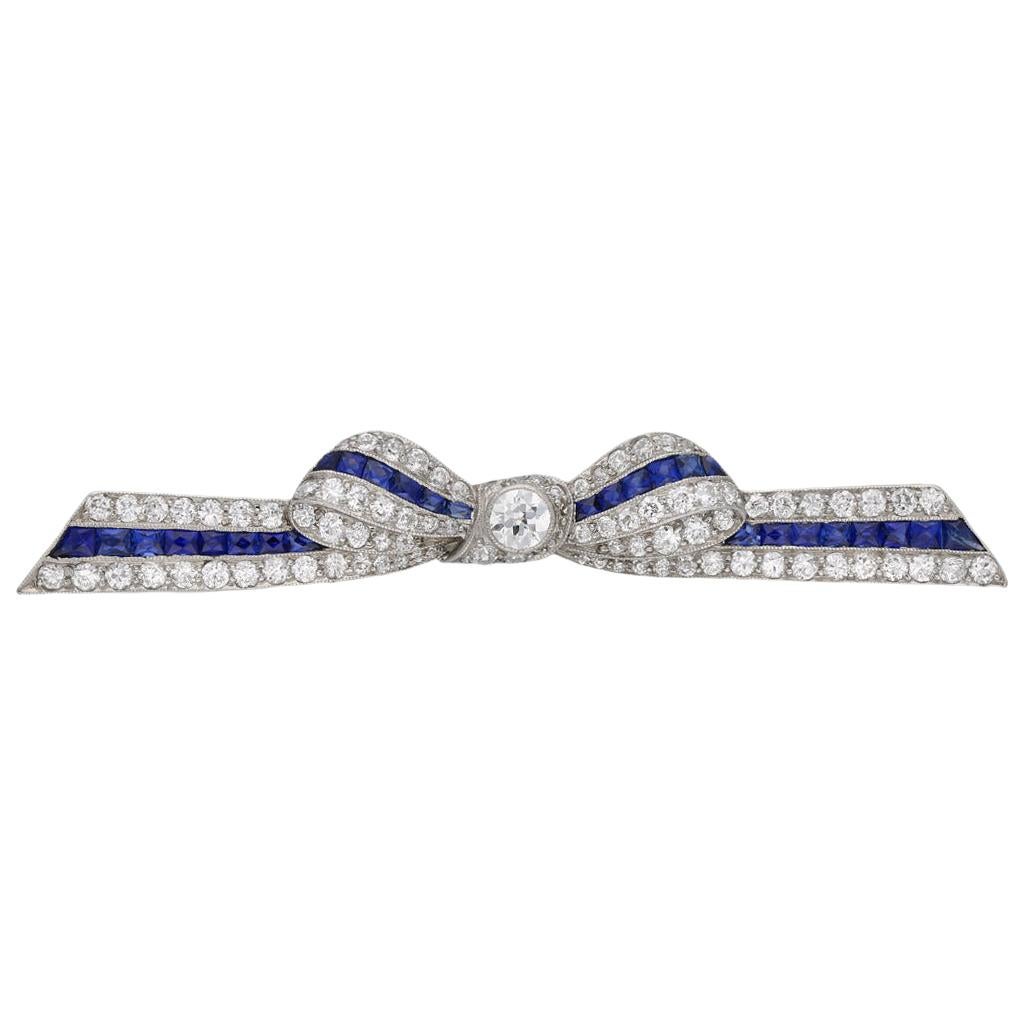Items Similar to Vintage 1940s Signed Monet Sterling Book Piece Greyhounds Brooch
Want more images or videos?
Request additional images or videos from the seller
1 of 8
Vintage 1940s Signed Monet Sterling Book Piece Greyhounds Brooch
About the Item
Rare 1940s sterling goldtone and pink gold plated two greyhounds brooch with security clasp. Marked "Monet Sterling." Measures: 2 1/4 inches tall by 2 15/16 inches wide. Condition: Very good for its age; light speckling throughout and very minor bend to the pin. An identical brooch is shown on pg. 113 of Alice Vega's book "Monet; The Master Jewelers."
Early Monet jewelry was produced in the United States and was not mass produced. During the 1960s and 1970s there was more demand than supply, because the company believed in quality over quantity. Monet's jewelry was of such a high caliber that during the 1980s they produced haute couture jewelry for Yves Saint Laurent.
- Creator:
- Metal:Sterling Silver
- Weight:4 oz
- Dimensions:Height: 2.25 in (57.15 mm)Width: 2.5 in (63.5 mm)Depth: 0.2 in (5.08 mm)Length: 2.25 in (57.15 mm)
- Style:Art Deco
- Place of Origin:United States
- Period:1940-1949
- Date of Manufacture:1940s
- Condition:Wear consistent with age and use. Very good for its age; light speckling throughout and very minor bend to the pin.
- Seller Location:Easton, PA
- Reference Number:1stDibs: LU3816222755672
About the Seller
No Reviews Yet
Vetted Seller
These experienced sellers undergo a comprehensive evaluation by our team of in-house experts.
Established in 2010
1stDibs seller since 2023
11 sales on 1stDibs
- ShippingRetrieving quote...Ships From: Easton, PA
- Return PolicyA return for this item may be initiated within 3 days of delivery.
More From This SellerView All
- Vintage Trifari Rhinestone Equestrian Riding Helmet & Polo Mallet Brooch, 1959By TrifariLocated in Easton, PAFlorentine finish goldtone polo mallet with pave faux-black diamond riding helmet brooch with security clasp. Marked crown "Trifari." Measures: 3 1/4 inches long by 1/2 inch. Excellent condition. This is a remake of a design which was first advertised in Mademoiselle magazine in 1937. This brooch was featured in a 1959 advertisement. Trifari is an American jewelry company founded in 1925 which sold costume jewelry to the middle to high end market. In 1930, Alfred Philippe, an immigrant from France, joined the company and became its lead designer. Philippe in his previous position in Paris had collaborated with Cartier and Van Cleef & Arpels, which influenced his designs for Trifari. In the 1930s, Trifari's jewelry was frequently used in Broadway productions. Their designs were also popular in Europe, owned by the Countess of Polignac as well as madame Lanvin's daughter and the director of Lanvin. Trifari also designed two sets of faux-pearl jewelry for Mamie Eisenhower. In 1955, Trifari won a landmark lawsuit protecting its copyrighted designs which were being copied by other costume jewelry companies. Early jewelry, jewelry featured in advertisements, or by well-known designers like Diane Love, Kunio...Category
Vintage 1950s American Brooches
MaterialsGold Plate
- Vintage 1980s Signed Nina Ricci Rhinestone Bird on a Branch BroochBy Nina RicciLocated in Easton, PA1980s gold plated pave clear rhinestone with faux-garnet eye bird on a branch brooch with security clasp. Marked "Nina Ricci." Measures: 1 1...Category
Vintage 1980s French Brooches
MaterialsGold Plate
- Vintage Signed Napier Ad Piece Silvertone "Golden Time" Sundial Brooch, 1954By NapierLocated in Easton, PASilvertone sundial brooch with security clasp. Marked "Napier." Measures: 2 1/8 inches long by 2 inches wide. Condition: Very good; tarnishing normal for its age. This is from Napier...Category
Vintage 1950s American Modern Brooches
MaterialsSilver Plate
- Vintage Signed Monet Goldtone White Sugarloaf Cabochon Brooch, 1984By MonetLocated in Easton, PAGoldtone textured white rhinestone sugarloaf cabochon brooch with security clasp. Marked "Monet." Measures: 1 3/8 inches tall by 2 5/8 inches wide. Condition: Very good; minimal wea...Category
Vintage 1980s American Art Deco Brooches
MaterialsGold Plate
- Vintage 1980s Signed Givenchy Hematite Finish Pave Clear Rhinestone BroochBy GivenchyLocated in Easton, PA1980s oval hematite finish pave clear rhinestone brooch with security clasp. Marked "Givenchy." Measures: 1 5/8 inches long by 2 1/6 inches wide. Excellent condition. Givenchy is a ...Category
Vintage 1980s American Modern Brooches
- Vintage 1950s Signed Napier Goldtone Big Faux-Pearl Dangles BroochBy NapierLocated in Easton, PA1950s goldtone big 3 faux-pearl dangles brooch with security clasp. Marked "Napier." Measures: 2 1/2 inches long by 2 1/2 inches wide. Condition: Very good; some discoloration to edge of goldtone. The matching earrings in silvertone are shown on pg. 302 of Melinda L. Lewis & Henry Swen's book "The Napier Co.: Defining 20th Century American Costume Jewelry." Vintage Napier jewelry...Category
Vintage 1950s American Brooches
MaterialsGold Plate
You May Also Like
- Cartier New York GIA Certified 11.24 Carat Old Mine Cushion Diamond BroochBy CartierLocated in Miami, FLMagnificent Cartier Art Deco Platinum and Diamond Brooch featuring a matching pair of important Old Mine Cut Diamonds weighing 5.60 carats and 5.64 carats. Both accompanied by a GIA report stating that they are H color VS1 and H color VS2 clarity. This brooch comes with an Expertise letter from IAJA (international Antique Jewelers...Category
Vintage 1930s American Art Deco Brooches
MaterialsDiamond, Platinum
- Carved Coral Buddha Pendant in 18k Gold Set with Diamonds, Emeralds and RubiesLocated in Honolulu, HIMAGNIFICENT large vintage Buddha pendant brooch in 18K yellow gold. This gorgeous pendant features a stunning Buddha carved in natural coral set...Category
Late 20th Century Unknown Pendant Necklaces
MaterialsCoral, Diamond, Emerald, Ruby, 18k Gold
- Line Vautrin "La Manif" Gilt Bronze BroochBy Line VautrinLocated in New York, NYGilt brooch by Line Vautrin (1913-1997), circa 1945-46. The design is known as ...Category
Vintage 1950s French Artisan Brooches
MaterialsBronze, Gilt Metal, Gold Plate, Brass
- Vintage Ruby Onyx and Diamond Classic Car BroochLocated in London, GBHere we have a superb vintage brooch. The piece has been crafted from 18ct yellow gold into the shape of a classic car from the 1930s. Automobiles of the 1930s exhibited many notable...Category
Vintage 1930s Brooches
MaterialsDiamond, Onyx, Ruby, Gold, Yellow Gold, Enamel
- Marcus & Co. Sapphire and Diamond Bow Brooch, American, circa 1935Located in London, GBSapphire and diamond bow brooch by Marcus & Co, American, circa 1935. A yellow gold and platinum bow form brooch set with one central row of twenty eig...Category
Vintage 1930s American Art Deco Brooches
MaterialsDiamond, Sapphire, Platinum
- John Brogden Shell Cameo Brooch and Earrings, English, circa 1870By John BrogdenLocated in London, GBAntique shell cameo brooch and earrings by John Brogden, English, circa 1870. A yellow gold suite of jewellery, the brooch composed of a horizontally situated oval Bull’s Mouth shell cameo of the Greek goddess Selene riding a serpentine dragon in a rubover collet setting, encircled by a conforming frame of gold beading and twisted gold wire punctuated with four gold palmette form plaques engraved and decorated with dark blue enamel and placed at the cardinal points, the reverse mounted with a hinged pin and scroll clasp, the earrings each composed of a vertical oval Bull’s Mouth shell cameo engraved with a bust length portrait of Selene with crescent-set headdress, encircled by a conforming frame matching that of the brooch with the addition of a pendant decoration composed of a horizontal bar of gold beading and twisted gold wires suspending gold link chains graduated from centre and ending in conical gold elements, the reverses mounted with French wire fittings, all in a fitted red leather case, the interior marked ‘FIRST CLASS PARIS MEDAL/ 1855.1867.1851/ PARIS FIRST CLASS & LONDON PRIZE MEDALS/ JOHN BROGDON/ Goldsmith/ MANUFACTORY/ 16, Henrietta St. Covent Garden/ London’. The cameo—defined as a gem, usually either a mineral or a shell, upon which a design has been carved in relief—is believed to have originated in Hellenistic Greece, during the third century BC. These miniature sculptures, at that time confined to the medium of hardstone, are thought to have been made with the primary purpose of personal adornment. The same practice of mounting cameos in jewellery was then continued by the Ancient Romans, and they are known to have been worn by many a Roman emperor. After the fall of Rome the fashion for cameos went into a decline, until it was again revived during the Renaissance period, brought about by a keen interest in the ancient world. At this time both antique and contemporary cameos were mounted in jewellery, as well as collected as objet d’art. The art of cameo cutting was revived in Italy, where it would remain a centre for the coming centuries. Again there was a lull in interest in carved gemstones, until the Neoclassical revival of the eighteenth century, largely stimulated by the discoveries of the ancient Roman cities of Pompeii and Herculaneum. As with the Renaissance, antique specimens were generally prized over modern cameos, and the worldliest men in Europe held them among their collections of art and antiques. That said, carving centres in Rome and Torre del Greco (near Naples) in Italy were established in response to the demand of the Grand Tourists, who travelled to Italy and Greece to become educated in the wonders of the ancient world. It was at this time that shell cameos, mostly made in Torre del Greco due to its proximity to the sea, became more popular, owing to the relative ease in carving shell over hardstone. In addition to Rome, hardstone cameos also became a specialty of Idar Oberstein, Germany, which had a long history with both the gem mining and cutting trade. In a shift away from the collector’s cases of the previous century, the nineteenth century saw a strengthening in the fashion for wearable cameos. After the Empress Josephine donned a cameo-set suite of jewellery at the coronation of Napoleon in 1804, cameo jewellery became all the rage. Napoleon played a further hand in promoting the art by establishing a gemstone carving school in Paris, inspired by his appreciation for the arts of the ancient world. By the mid-nineteenth century shell cameos, in part due to their lightness compared with hardstone cameos, were the height of fashion. Large shell cameos as well as hardstone cameos were set into contemporary mounts, often as suites of jewellery. Some of the best cameos of the nineteenth century—carved by a select group of recognized carvers—were set into revivalist mounts, corresponding to the subject matter. In Victorian England cameo jewellery was particularly prized, due in part to the fact that the Queen owned and wore a number of cameo jewels. One example which can often be seen in official portraits is the Badge of the Order of Victoria and Albert, carved by Tommaso Saulini of Rome, who also produced cameos for the maker of the present suite, John Brogden. To meet demand some carvers set themselves up in London, including William Schmidt, a German carver from Idar Oberstein, who produced cameos for top London jewellers, including Brogden, Carlo Giuliano and Child & Child. In fact, Schmidt purports to have been the first to carve cameos out of opal, which Brogden reportedly displayed in the Paris Exhibition of 1878. An extant example, now in the collection of the British Museum, was set by the Giuliano firm. Regarding subject matter, cameos throughout time have been largely figural, from bust length profile portraits to scenes with multiple full-length figures, and sometimes animals. Ancient Greek and Roman cameos often depicted mythological scenes as well as contemporary figures. During the Renaissance, mythological scenes were popular, often taken directly from ancient sculpture, as well as portraits of notable contemporary figures. During the eighteenth and nineteenth centuries, due to the revivalist styles, both Renaissance and Classical subjects were copied and set into matching (and sometimes unmatching) revivalist mounts. From the Renaissance through the Victorian era, being able to recognize the source of the carving in a cameo was a mark of erudition, revealing in the wearer knowledge of Classical art. As mentioned, the present cameo parure...Category
Antique 1870s English Victorian Brooches
MaterialsYellow Gold
Recently Viewed
View AllMore Ways To Browse
Art Signed Vintage Jewelry
Jewellery Book
Jewelry Book
Vintage Couture Jewelry
Haute Couture Jewellery
Haute Couture Jewelry
Goldtone Jewelry
Monet Jewellery
1940s Couture
Monet Vintage
Brooch Book
Saint Laurent United States
Monet Jewellery Vintage
Monet Vintage Jewellery
Vintage Monet Jewelry
Vintage Monet Monet Jewelry
Gold Greyhound
Monet Book





